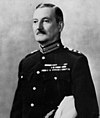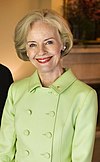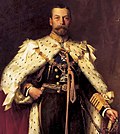Governor of Queensland
| Governor of Queensland | |
|---|---|
AC PSM since 1 November 2021 | |
| Viceregal | |
| Style | Her Excellency The Honourable |
| Residence | Government House, Brisbane (Fernburg) |
| Nominator | Premier of Queensland |
| Appointer | Monarch of Australia on the advice of the Premier |
| Term length | At His Majesty's pleasure (usually 5 years by convention) |
| Formation | 10 December 1859 |
| First holder | Sir George Bowen |
| Salary | |
| Website | govhouse |
The governor of Queensland is the representative in the state of
The current governor of Queensland, former
The chief justice of the Supreme Court of Queensland, currently Helen Bowskill, acts in the position of governor in the governor's absence. In June 2014, Queen Elizabeth II, upon the recommendation of then-premier Campbell Newman, accorded all current, future and living former governors the title The Honourable in perpetuity.[7]
Official residence
The governor has resided at
Constitutional provisions
The office of the governor was initially established by
The Constitution Act 2001 consolidated the previous constitutional documents, including the most recent letters-patent, leaving the role of the governor fully defined by Australian law.[11] However, the doubly entrenched provisions of the 1867 constitution remains in place as a referendum was not sought to amend them.[10]
In accordance with the conventions of the
The Queensland constitution expressly provides that the governor "is not subject to direction by any person and is not limited as to the Governor's sources of advice" on the appointment or dismissal of ministers (s 35), another provision inserted by the Bjelke-Petersen government in the wake of the 1975 federal dismissal. This provision worked against Bjelke-Petersen when, in the dying days of his government in November 1987, he tried and failed to convince governor Sir
The governor is head of the
Governor's standard
The governor's standard comprises a union jack with a white roundel in the centre with the state badge of Queensland: a light blue maltese cross, surmounted by a royal crown and surrounded by garland of laurel leaves.[citation needed]
The general design of standards for British governors was approved by Queen Victoria in 1869. The design for governors of Queensland was created and flown as a personal standard since 1876, when the maltese cross was adopted as the colonial badge.[citation needed]
If the standard is flying at Government House, on a vehicle or at an event, this indicates that the governor is present.[citation needed]
- Past and present standards of the governor
-
1870–1876
-
1876–1901, bearing an Imperial crown
-
1901–1963, bearing aTudor crown
-
1963–present, bearing aSt. Edward's crown
List of governors of Queensland
The first Australian- (and Queensland-) born governor of Queensland was Lieutenant-General Sir John Lavarack (appointed 1946). His successor, Sir Henry Abel Smith (a relative of the royal family), was British. All subsequent governors have been Australian-born, except for Leneen Forde, who was born in Canada but who emigrated to Australia at an early age.
Prior to the separation of Queensland in 1859, it was part of New South Wales under the governors of New South Wales.
| No. | Portrait | Title Governor Office (Birth–Death) |
Term of office | Monarch | |
|---|---|---|---|---|---|
| 1 | 
|
GCMG (1821–1899) |
10 December 1859 |
4 January 1868 |
Victoria
(1837–1901) |
| 8 years and 26 days | |||||
| 2 | 
|
Colonel the Honourable Samuel Blackall (1809–1871) |
14 August 1868 |
2 January 1871 | |
| 2 years and 142 days | |||||
| 3 | 
|
GCMG (1819–1890) |
12 August 1871 |
12 November 1874 | |
| 3 years and 93 days | |||||
| 4 | 
|
The Honourable KCMG (1828–1888) |
23 January 1875 |
14 March 1877 | |
| 2 years and 51 days | |||||
| 5 | 
|
The Honourable CB (1809–1883) |
20 July 1877 |
2 May 1883 | |
| 5 years and 287 days | |||||
| 6 | 
|
The Honourable GCMG (1828–1888) |
6 November 1883 |
9 October 1888 | |
| 4 years and 339 days | |||||
| 7 | 
|
GCMG, CIE (1826–1904) |
1 May 1889 |
31 December 1895 | |
| 6 years and 245 days | |||||
| 8 | 
|
The Right Honourable Charles Cochrane-Baillie 2nd Baron Lamington (1860–1940) |
9 April 1896 |
19 December 1901 | |
| 5 years and 255 days | Edward VII
(1901–1910) | ||||
| 9 | 
|
Lieutenant General the Honourable CB (1850–1929) |
24 March 1902 |
10 October 1904 | |
| 2 years and 201 days | |||||
| 10 | 
|
The Honourable KCMG (1868–1933) |
30 November 1905 |
26 May 1909 | |
| 3 years and 178 days | |||||
| 11 | 
|
The Right Honourable CB, AM (1846–1919) |
2 December 1909 |
16 July 1914 | |
| 4 years and 227 days | George V
(1910–1936) | ||||
| 12 | 
|
Major The Honourable CB (1858–1920) |
15 March 1915 |
3 February 1920 | |
| 4 years and 326 days | |||||
| 13 | 
|
GCMG (1862–1939) |
3 December 1920 |
17 September 1925 | |
| 4 years and 289 days | |||||
| 14 | 
|
DSO (1871–1960) |
13 July 1927 |
7 April 1932 | |
| 4 years and 270 days | |||||
| 15 | 
|
Lieutenant Colonel the Right Honourable DSO (1876–1955) |
13 June 1932 |
23 April 1946 |
Edward VIII
(1936) |
| 13 years and 315 days | George VI
(1936–1952) | ||||
| 16 | 
|
Lieutenant General the Honourable DSO (1885–1957) |
1 October 1946 |
4 December 1957 | |
| 11 years and 65 days | Elizabeth II
(1952– | ||||
| 17 | 
|
Colonel the Honourable DSO (1900–1993) |
18 March 1958 |
18 March 1966 | |
| 8 years and 1 day | |||||
| 18 | 
|
The Honourable KCVO (1902–1980) |
21 March 1966 |
21 March 1972 | |
| 6 years and 1 day | |||||
| 19 | 
|
Air Marshal the Honourable CB (1914–1978) |
21 March 1972 |
20 March 1977 | |
| 5 years and 0 days | |||||
| 20 | 
|
Commodore the Honourable (1916–1986) |
22 April 1977 |
21 July 1985 | |
| 8 years and 91 days | |||||
| 21 | 
|
QC (1921–2004) |
22 July 1985 |
29 July 1992 | |
| 7 years and 8 days | |||||
| 22 | 
|
The Honourable AC (b. 1935) |
29 July 1992 |
29 July 1997 | |
| 5 years and 1 day | |||||
| 23 | 
|
CVO (b. 1940) |
29 July 1997 |
29 July 2003 | |
| 6 years and 1 day | |||||
| 24 | 
|
The Honourable AC (b. 1942) |
29 July 2003 |
29 July 2008 | |
| 5 years and 1 day | |||||
| 25 | 
|
The Honourable AC (b. 1946) |
29 July 2008 |
29 July 2014 | |
| 6 years and 1 day | |||||
| 26 | 
|
QC (b. 1948) |
29 July 2014 |
1 November 2021 | |
| 7 years and 96 days | |||||
| 27 | 
|
AC, PSM (b. 1963) |
1 November 2021 |
Incumbent | |
| Charles III
( | |||||
| 2 years and 169 days | |||||
List of administrators and lieutenant-governors of Queensland
| Name | Term | Notes |
|---|---|---|
| Maurice Charles O'Connell | 4 January 1868 – 14 August 1868 | Administrator |
| Maurice Charles O'Connell | 2 January 1871 – 12 August 1871 | Administrator |
| Maurice Charles O'Connell | 12 November 1874 – 23 January 1875 | Administrator |
| Maurice Charles O'Connell | 14 March 1877 – 10 April 1877 | Administrator |
Arthur Edward Kennedy
|
10 April 1877 – 20 July 1877 | Administrator |
| Joshua Peter Bell | 19 March 1880 – 22 November 1880 | Administrator |
| Arthur Hunter Palmer | 2 May 1883 – 6 November 1883 | Administrator |
| Arthur Hunter Palmer | 20 April 1886 – 13 December 1886 | Administrator |
| Arthur Hunter Palmer | 9 October 1888 – 1 May 1889 | Administrator |
| Arthur Hunter Palmer | 15 November 1895 – 9 April 1896 | Lieutenant Governor Administrator |
| Samuel Griffith | 21 June 1901 – 24 March 1902 | Lieutenant Governor |
Hugh Muir Nelson
|
10 October 1904 – 30 November 1905 | Lieutenant Governor |
Arthur Morgan
|
27 May 1909 – 2 December 1909 | Lieutenant Governor |
| Arthur Morgan | 16 July 1914 – 15 March 1915 | Lieutenant Governor |
| William Lennon | 3 February 1920 – 3 December 1920 | Lieutenant Governor |
| William Lennon | 17 September 1925 – 13 June 1927 | Lieutenant Governor |
| William Lennon | 8 May 1929 – 2 June 1929 | Lieutenant Governor |
James William Blair
|
7 April 1932 – 1 June 1932 | Administrator |
| James William Blair | 17 May 1937 – 21 November 1937 | Administrator |
Frank Cooper
|
24 April 1946 – 30 September 1946 | Lieutenant Governor |
| Alan Mansfield | 25 January 1957 – 18 March 1958 | Administrator |
| Alan Mansfield | 31 March 1960 – 24 May 1960 | Administrator |
| Alan Mansfield | 18 April 1963 – 18 October 1963 | Administrator |
William Mack
|
10 March 1966 – 21 March 1966 | Administrator |
| William Mack | 20 March 1969 – 30 June 1969 | Administrator |
| Joseph Aloysius Sheehy | 30 June 1969 – 18 September 1969 | Administrator |
| Mostyn Hanger | 9 March 1972 – 21 March 1972 | Administrator |
| Mostyn Hanger | 21 March 1977 – 22 April 1977 | Administrator |
Notes
- ^ equivalent to £575,544 in 2021.[1]
- ^ The salary of the Governor is set out in the Governors (Salary and Pensions) Amendment Regulation 2021, which states that the salary of the governor is to be equal to the amount of the Chief Justice of Queensland under the Judicial Remuneration Act 2007.[2] In section 27 of the Judicial Remuneration Act 2007, the salary for the Chief Justice is to be "published by gazette notice, the adjusted salary or allowance."[3] As of July 2019 the salary was A$488,686, not including allowance.[4]
References
- ^ "Queensland Blue Book – 1900". Internet Archive. 1900.
- ^ "Governors (Salary and Pensions) Amendment Regulation 2021". legislation.qld.gov.au. Parliament of Queensland. 2021. Archived from the original on 27 January 2023. Retrieved 27 January 2023.
- ^ "Judicial Remuneration Act 2007". legislation.qld.gov.au. Parliament of Queensland. Archived from the original on 27 January 2023. Retrieved 27 January 2023.
- ^ "Judicial Salaries – Gazette Notice" (PDF). courts.qld.gov.au. Archived (PDF) from the original on 27 January 2023. Retrieved 27 January 2023.
- ^ "Role of the Governor". Government House Queensland. Archived from the original on 4 March 2022. Retrieved 7 December 2023.
- ^ "Dr Jeannette Young Queensland's New Governor". Ministerial Media Statements. Archived from the original on 24 June 2021. Retrieved 21 June 2021.
- ^ "20 June 2014" (PDF). Queensland Government Gazette. p. 15. Archived (PDF) from the original on 19 March 2018. Retrieved 20 March 2018.
- ^ "Government House (entry 600275)". Queensland Heritage Register. Queensland Heritage Council. Retrieved 1 August 2014.
- ^ "Old Government House (entry 600118)". Queensland Heritage Register. Queensland Heritage Council. Retrieved 10 December 2023.
- ^ Austlii.
- ^ Constitution of Queensland 2001 (Qld) s ch4
- Queensland Parliament. Archivedfrom the original on 25 November 2017. Retrieved 25 November 2017.
- Queensland Parliament. 2014. Archived(PDF) from the original on 30 March 2016. Retrieved 15 December 2016.
Further reading
- Fagan, David; King, Madonna (2021). The Governors Of Modern Queensland. University Of Queensland. ISBN 9780702263019.











